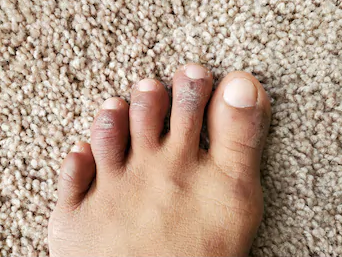If you’re prone to developing chilblains in your toes and feet during winter, read on to find out why they happen and what you can do to prevent them.
Chilblains are often painful and itchy and can potentially lead to ulcers. They happen in winter for most people, but also for people who work in very cold icy temperatures such as cool rooms.
They appear as reddish-purple patches on your feet over a few hours, which can become itchy, painful, swell up and cause blisters. They can happen in children, adults and the elderly and will normally disappear after two to three weeks, unless they become ulcerated which can lead to further problems. At our podiatry clinic, we’ll help you with general footcare to treat and minimise the incidence of chilblains in your feet.
What causes chilblains?
Chilblains occur when the skin is constantly exposed to very cold air. The small blood vessels in the skin (both arteries and veins) of your toes and feet become constricted with the cold. When your feet warm up, these blood vessels may expand too quickly leaking blood into the surrounding tissues, causing swelling and pain. Chilblains are also known as pernio or perniosis.
The symptoms of chilblains include the following:
- Itchy reddish-purple areas on your skin that may be painful
- A burning sensation on your skin
- Patches swelling on the skin surface
- Developing blisters on your skin which may become ulcers
Why Chilblains occur for some people and not others is not generally known, but we do know what increases the risks of developing them which include:
- Cool and damp climate – when the weather is cool and damp, the risk of developing chilblains is higher. In cold and dry climates, people are acclimatised and equipped to deal with these temperatures.
- Shoes which are too tight in cold, damp conditions will increase the susceptibility to chilblains.
- Poor circulation – people who have poor circulation often don’t manage temperature fluctuations as well and are more prone to developing chilblains.
- Women are statistically more likely to get chilblains that men.
- Underweight – people with less than normal range of body fat are more susceptible to sudden temperature fluctuations and chilblains.
- Lack of movement – the elderly or people who are more sedentary have a higher risk of developing chilblains.
- Medical conditions such as Lupus (autoimmune disorder) or Anaemia increase the risk of developing chilblains.
How to avoid chilblains on your feet this winter
There are ways to prevent or minimise the occurrence of chilblains on your feet this winter. You may want to get some professional advice from Sanders Podiatry Clinic, or try the following at home first and see how you go.
- Stop smoking because nicotine constricts blood vessels
- Minimise draughts in your home and workplace – close windows and doors
- Keep your indoors warm
- Wear proper fitting shoes with room for your toes to move, and if your shoes get wet remove them immediately
- Wear thick woollen socks and footwear that protects your feet from the elements – water, damp and ice
- Massage your feet to ease the circulation and gradually open up the blood vessels again
If your feet get cold and you feel chilblains coming on, warm them up slowly. Sudden temperature fluctuations can make chilblains worse.
How we help at the podiatry clinic
Our gentle and experienced podiatrists will evaluate your chilblains for any underlying problems to do with autoimmune diseases, poor circulation due to diabetes or any other potential problem. If the chilblains persist, we’ll help you with treatment which provides some relief from discomfort and we may discuss vasodilator medications to relax blood vessels.
The best treatment however for chilblains is preventive so our recommendation is to take all precautions necessary to prevent from happening.
See one of our podiatrists to make sure there is no other underlying problem related to your chilblains
Our podiatry team will assess your feet for any other possible condition that could be the underlying cause of chilblains. They will also provide massage techniques and other therapies to help relieve the pressure and discomfort of chilblains. We’ll teach you how to take better care of your feet at home and what to do should they happen.
Sanders Podiatry provide holistic personalised podiatry care from our locations in Adelaide and the Adelaide Hills.
Sander Podiatry Adelaide – 08 8379 1456 (Greenhill Podiatry)
